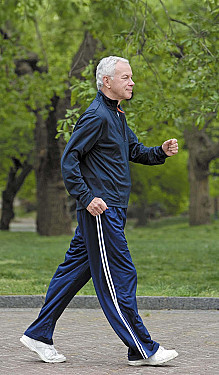Take time to stretch
A regular routine can help you avoid injury and improve your flexibility.
- Reviewed by Howard E. LeWine, MD, Chief Medical Editor, Harvard Health Publishing; Editorial Advisory Board Member, Harvard Health Publishing
 Many people don't bother with regular stretching, but they should. It's a small investment that offers big payouts.
Many people don't bother with regular stretching, but they should. It's a small investment that offers big payouts.
A regular stretching routine can help reduce your risk of injuries, improve your mobility to protect against falls, and increase your flexibility, which studies have linked with greater longevity.
But as with financial accounts, consistent investment is essential for long-term success. "Stretching now and then won't provide lasting benefits," says Eric L'Italien, a physical therapist at Harvard-affiliated Spaulding Rehabilitation Center. "You need to commit to an ongoing routine."
Stretching is split into two types: dynamic and static. Think of dynamic stretching as warming up and static stretching as recovery. Here's how to incorporate them into your daily life.
Dynamic stretching
Dynamic stretching involves a series of moves that carry joints and muscles through their normal range of motion. "It helps loosen your joints to expand your range of motion and improve blood flow to muscles and tissues throughout your body," says L'Italien.
A dynamic stretching routine is ideal as a warm-up before an activity or exercise or as a morning ritual to prepare your body for the day ahead. There are many dynamic stretching movements, but L'Italien recommends this all-around routine. Complete the entire sequence twice.
1. Leg swings. Stand tall with your feet flat on the floor and your hands on your hips, or with one hand gripping the back of a chair for balance. Lift one leg and swing it straight forward and then backward in a controlled pendulum-like fashion. Continue for 10 to 20 swings. Switch legs and repeat.
2. Arm circles. Extend your arms out to the sides and move them in forward circles of increasing size (small, medium, and large) for 30 seconds, and then move them in backward circles of increasing size for 30 seconds.
3. Knee lifts. Stand with your feet together and your arms at your sides. Lift your right knee as if you're marching, and touch both hands to your knee. (See image above.) Return to the starting position, and repeat the movement with your left leg. Repeat the entire sequence, increasing the pace, 10 to 20 times.
4. Torso rotations. Stand with your feet hip-width apart and arms at your sides. Shift your weight onto your left foot and twist your body to the left, while you swing your right arm across your body and tap your right foot out to the side to extend the stretch. Return to the starting position, and repeat, twisting to the right. Do this sequence 10 to 20 times.
Static stretching
Static stretching involves adopting and holding a position that lengthens a muscle or group of muscles. Static stretching should be performed after muscles have warmed up.
Static stretching helps with muscle recovery and to reduce soreness and injury. While static stretching can focus on specific muscles used in an activity or exercise, L'Italien suggests a staple routine that includes the Big Three: hamstrings, hip flexors, and calves.
"These muscles are often tight in men, and no matter what activity or exercise you do, they always need attention afterward," he says.
Here are three static stretches that work the Big Three. Hold each stretch so you feel mild tension, and don't bounce during the stretch, which can increase the risk of injury. Do each stretch two or more times to reach a total of 60 seconds in the "hold" position. Then repeat with the other leg.
Hamstring stretch. Stand up straight with your arms at your sides. Extend your left leg out in front of you while keeping your leg straight with your heel grounded on the floor and toes pointing to the ceiling.
Place your hands on your upper thighs for support and hinge forward from the hip, keeping your spine neutral (no rounding or arching). Bend your right knee and lower your buttocks, as though you were starting to sit, until you feel a stretch up the back of your left thigh. Hold. Return to the starting position.
Kneeling hip flexor stretch. Kneel with your hands at your sides. Put your right leg in front of you, your knee bent at a 90° angle, and your foot flat on the floor. Place your hands on your right thigh for support. Lean forward, pressing your left hip forward while keeping your right foot on the floor. Don't let your knee go farther forward than your toes. Feel the stretch in the front of your left thigh and hip. Hold. Return to the starting position.
Calf stretch. Hold the back of a chair or press your hands against a wall, arms extended in front at shoulder height. Extend your right leg straight back and press the heel against the floor. Allow your left knee to bend while keeping that heel grounded on the floor. Feel the stretch up the back of your right calf. Hold. Return to the starting position.
Image: © Edwin Tan/Getty Images
About the Author

Matthew Solan, Executive Editor, Harvard Men's Health Watch
About the Reviewer

Howard E. LeWine, MD, Chief Medical Editor, Harvard Health Publishing; Editorial Advisory Board Member, Harvard Health Publishing
Disclaimer:
As a service to our readers, Harvard Health Publishing provides access to our library of archived content. Please note the date of last review or update on all articles.
No content on this site, regardless of date, should ever be used as a substitute for direct medical advice from your doctor or other qualified clinician.















